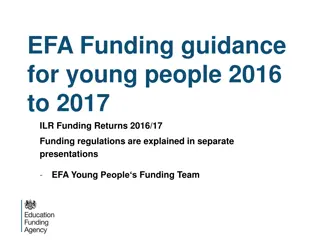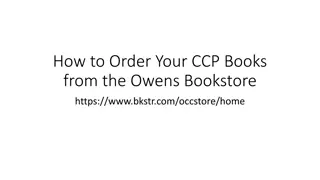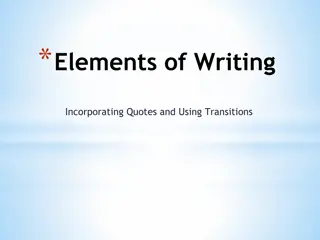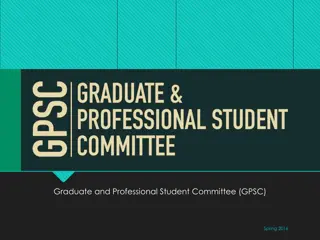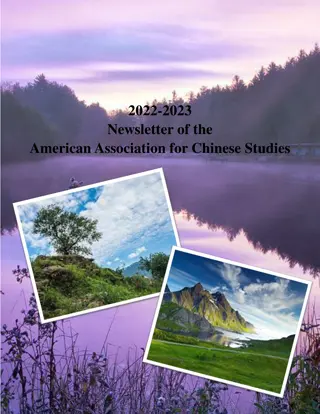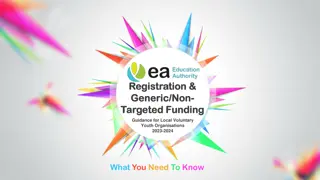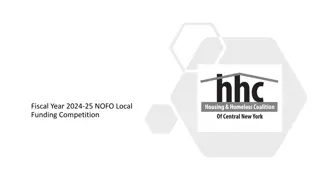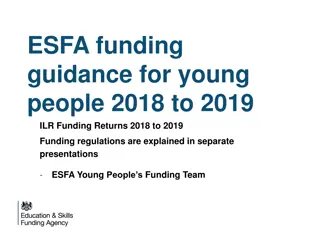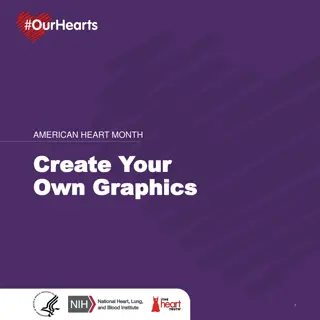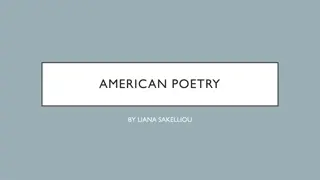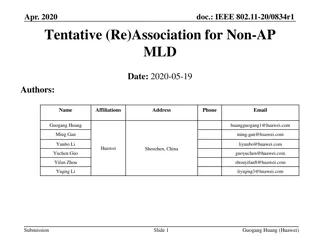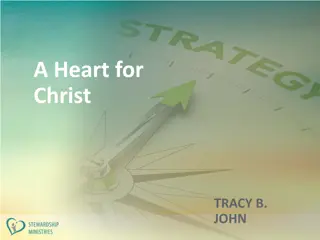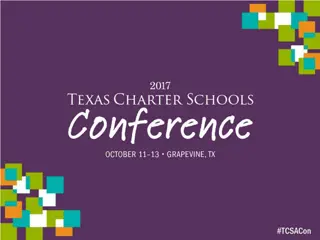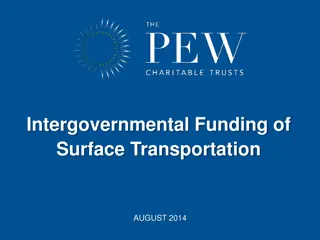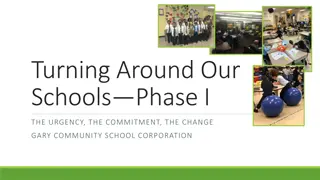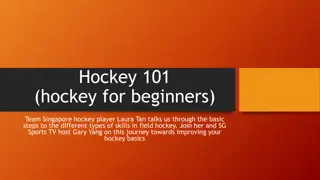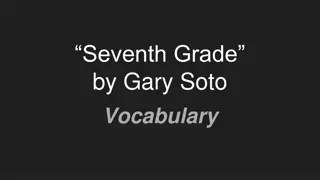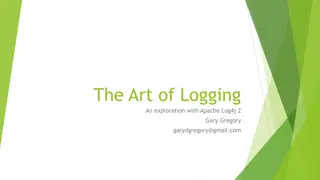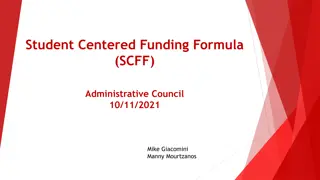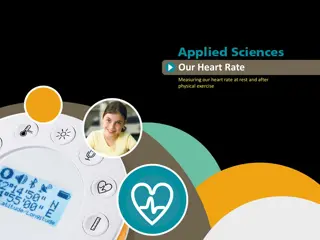Optimizing Funding Success with American Heart Association: Insights from Dr. Gary K. Owens
Dr. Gary K. Owens, a distinguished expert in molecular physiology and internal medicine, shares his expertise and success in securing AHA fellowships and grants. With a track record of high funding rates for trainees, strategic research proposals, and active grants exceeding $5M/year, Dr. Owens' experience provides invaluable guidance on navigating the AHA's grant application process and increasing funding success.
Download Presentation

Please find below an Image/Link to download the presentation.
The content on the website is provided AS IS for your information and personal use only. It may not be sold, licensed, or shared on other websites without obtaining consent from the author. Download presentation by click this link. If you encounter any issues during the download, it is possible that the publisher has removed the file from their server.
E N D
Presentation Transcript
2020 AHA Fellowship Grant Writing Workshop Dr. Gary K. Owens Professor of Molecular Physiology and Biological Physics Professor of Internal Medicine, CV Division Director Robert M. Berne Cardiovascular Research Center PI of the CVTG (NIH T32 HL007284) PI of our SRIP Training Grant (NIH R25 HL088724)
"Optimizing your funding success with the American Heart Association" 1.My personal experiences with the AHA 2.General Information and Deadlines 3.How the Review Process Works 4. How to write a successful grant proposal
My Personal Experience with the AHA Fellowships: 1. Former member and chair of the AHA Review Panel. 2. >35 successful pre- and post-doctoral applications by my trainees about a 90% funding rate. 3. Currently have 1 graduate student and 3 post docs or Research Scientists who are current or past AHA fellowship recipients in my lab.
G.K. Owens Active Extramural Grants (> $5M/year): Gary K Owens (PI) PDGF receptor activation promotes athero-protective changes in SMC phenotype. The focus of this proposal is to test the hypothesis that PDGF R-dependent phenotypic transitions of SMC within advanced atherosclerotic plaques are beneficial resulting in smaller lesions and augmentation of multiple indices of plaque stability. This grant was received an impact score of 10 (1st percentile). R01 HL132904 04/01/2017 3/31/2021 $651,534/year Gary K Owens (PI) 08/01/2017-04/30/2021 R01 HL135018 Oct4 and Klf4 regulate microvascular SMC-pericyte plasticity and angiogenesis. Studies in this proposal will test the overall hypothesis that the stem cell pluripotency genes Oct4 and Klf4 play a critical role in regulating the plasticity of microvascular SMC-P during vascular remodeling in response to injury and hypoxia, as well as development of microvascular inflammation and dysfunction associated with obesity and metabolic disease. This grant received an impact score of 16 (2nd percentile). R01 HL136314 Gary K Owens (PI) Defining SMC phenotypes critical in late stage atherosclerosis pathogenesis. Studies in this proposal will test the hypothesis that SMC phenotypic transitions can exert dominant atheroprotective or atheropromoting effects on atherosclerotic lesion pathogenesis and should be one of the primary therapeutic targets for treating advanced atherosclerosis. This grant received an impact score of 16 (1st percentile). $766,787/year 01/01/2018-12/31/2021 $739,747/year R01 HL141425-01 IL1beta signaling in SMC promotes beneficial changes in late stage atherosclerotic lesion pathogenesis. The major goals of this project are to investigate the mechanisms by which IL1b and IL1 receptor signaling in smooth muscle cells, macrophages, and/or endothelial cells promote stabilization of late stage atherosclerotic plaques. It was reviewed by AICS June 2018 and received a priority score of 26 (6th percentile). GK Owens (PI) 2/01/2019-1/30/2023 $794,598/year Leducq Foundation TransAtlantic Network GK Owens (co-PI) 01/2019-12/2024 Defining the Roles of Smooth Muscle Cells and Other Extracellular Matrix Producing Cells in Late Stage Atherosclerotic Plaque Pathogenesis (PlaqOmics). My European co-PI is Gerard Pasterkamp, UMC Utrecht. It also includes labs for Mount Sinai (Johan Borkergren), U Lubeck(J Erdmann), Kings College London (M Mayr), U Munich (M Joner and H Schunkert), CVPath USA (R Vermani) and Stanford (N Leeper). Our overall hypothesis is that detrimental reprogramming of SMC destabilizes atherosclerotic plaques and that there are critical genetic determinants of CAD risk that act in part by impacting SMC phenotypic transitions. $6M for 5 years UVA-AstraZeneca Cardiovascular Research Alliance Gary K. Owens (Director) 12/01/09- 12/31/2020 (NCE) This is a research alliance between the UVA CVRC and the CV Group at AstraZeneca Pharmaceutical that is directed by Dr. Owens. It currently provides $650K in base funding each year in support of team-based translational research projects currently focused on heart failure, atherosclerosis, and vascular complications of diabetes and metabolic disease. AstraZeneca also provides additional funding for ongoing projects and since 2009 they have provided >$11M in funding for nearly 80 PIs at UVA. $650,000/year Gary K. Owens (PI) 07/01/1977-6/30/2022 $814,290/year T32 HL007284-42 Basic Cardiovascular Training Grant. This training grant supports 8 pre-doctoral students and 8 post-doctoral fellows per year. R25 HL088724-11 Short Term Training to Increase Diversity in Health Related Research. This training grant supports stipends for 15 URM students in our SRIP each summer. Gary K. Owens (PI) 05/01/2007-6/30/2023 $133,448/year
"Optimizing your funding success with the American Heart Association" 1.My personal experiences with the AHA 2.General Information and Deadlines 3.How the Review Process Works 4. How to write a successful grant proposal
General Information: https://professional.heart.org/professional/ResearchPrograms/ApplicationInformation/UCM_443316_ Predoctoral-Fellowship.jsp Objective To enhance the integrated research and clinical training of promising students who are matriculated in pre-doctoral or clinical health professional degree training programs and who intend careers as scientists, physician-scientists or other clinician-scientists, or related careers aimed at improving global cardiovascular health. Science Focus All basic, clinical, behavioral, translational and population research broadly related to cardiovascular function and disease and stroke, or to related clinical, basic science, bioengineering or biotechnology, and public health problems. The 2020 Deadline for AHA Pre-Doctoral Grants is August 14, 2020 and August 15th for Post-Doctoral Grants. Also, please remember that your grant needs to be into the UVA Grants Office at least one week prior to this deadline! Allow plenty of time for multiple rounds of revision by your mentor and others (including a CVTG Grant Brewing Session), and for doing all the regulatory paperwork. I recommend starting to draft your specific aims including a testable hypothesis NOW!
2018- 2019 AHA Grant Success Rates https://professional.heart.org/professional/ResearchPrograms/AH AResearchAccomplishments/TopAdvancesInResearch/UCM_444 458_Success-Rates.jsp Pre-doctoral Fellowships 37% (168/454) Post-doctoral Fellowships 43% (255/594)
NIH pay-lines are currently between the 12th-16th percentile depending on the Institute. SOLUTION: You not only have to do outstanding science, but you also need to write outstanding grants. Try to learn to like the grant writing process and view it as an important part of doing the best science possible. The most important factor in your getting a faculty position at a top academic medical center is your ability to obtain extramural grants even in tough times.
"Optimizing your funding success with the American Heart Association" 1.My personal experiences with the AHA 2.General Information and Deadlines 3.How the Review Process Works 4. How to write a successful grant proposal
How the Review Process Works Prior to Study Section Try to put yourself in the mindset of the Reviewer. Look up members of the study section prior to writing your grant. 1. Proposals are assigned to a specific AHA review panel based on the specific codes you select describing your grant. Reviewers get their grant assignments approximately 6-weeks prior to the review meeting. The average time a reviewer spends reviewing your grant is 2-4 hours. Each Reviewer receives 12-14 applications: 12 x 3 = ~36 hours. It is a huge time commitment and reviewers get really annoyed if grants are poorly written and hard to understand! Each application is assigned a: Primary Reviewer (R1) Secondary Reviewer (R2) Reader (R3) 6. The Reviewer critiques and scores applications according to AHA guidelines (Scale of 1-5, where 1 is outstanding). 7. All scores are posted online 1 week prior to study section for other reviewers to observe. 2. 3. 4. 5.
How the Review Process Works the Day of the Review 1. The review panels typically have 20-25 members, but your grant will only be read by one primary reviewer, one secondary reviewer, and one reader. However, all review panel members will vote. 1/2 of fellowship proposals will be triaged based on preliminary scores assigned by the three reviewers prior to the meeting. If not triaged, the primary reviewer of your grant will give a brief (4-5 minute) summary of the project along with strengths, weaknesses, overall impact, novelty, and significance of the science, as well as consideration of your mentor-training environment, the training plan, and your credentials. The secondary and reader will then add any additional comments, or simply state they agree if this is the case. The reviewers will then state their recommendations for scoring and the entire panel will record their scores. The entire review process is unlikely to last more than 8-10 minutes! Also keep in mind that reviewers may have 10-15 other grants to read and review and simply will not spend time trying to figure out a poorly written grant. As such, your grant needs to be written as clearly and succinctly as possible to facilitate the job of your reviewers. If they struggle to understand your grant, it is likely to do very poorly even if the science is strong. Make sure to include sentences/phrases the reviewers of your grant can recite to other panel members when your grant is reviewed to highlight its merits. 2. 3. 4. 5. 6. 7. 8. 9.
Review Criteria for AHA Pre-doctoral Fellowships: Criterion 1 - Evaluation of the Investigator Does the trainee have potential to be successful independent researcher? Are the trainee's career plans specified in the application? Is this supported by the trainee's academic record and the assessment provided by the three letters of reference? Does the trainee have prior research experience and/or publications? Is there a clear rationale supporting the need for the proposed training? What is the sponsor's assessment of the applicant? The AHA Review Panels tend to be ultra-conservative when it comes to risk. Keep your grant well-focused and as simple as possible. Criterion 2 Sponsor/Training Plan and Environment Sponsor/Training Plan Is the mentor an independent investigator? Does the mentor have the experience to direct the proposed research training, as evidenced by a track record regarding productivity, funding and prior trainees? Does the mentor have adequate current funding to support the fellow's project? Does the mentor provide a comprehensive training plan that will facilitate the applicant's progress towards his/her research career goals? Environment Does the scientific environment in which the work will be done contribute to the probability of success for the training experience? Is there evidence of institutional commitment? Criterion 3 - Evaluation of the Proposal Significance: Does this study address an important problem broadly related to cardiovascular disease or stroke? What will be the effect of these studies on the concepts, methods and technologies that drive this field? Approach: A new fellow may not have had adequate time to generate preliminary data. Applicants can present preliminary data generated by the sponsor. The assessment of preliminary data, whether generated by the sponsor or the applicant, should be put into perspective so that bold new ideas and risk taking by beginning investigators are encouraged rather than stymied. Are the conceptual framework, design, methods and analyses adequately developed, well integrated, well reasoned, feasible (as determined by preliminary data or the expertise available in the mentor's and/or collaborator's laboratories) and appropriate to the aims of the project? Does the applicant acknowledge potential problem areas and consider alternative tactics? Innovation: Is the project original?
The page limit is now 5 pages! The overall score may not be the arithmetic mean! 1.3 1.9 2.5 1.9 (1.8-2.0)
1. The SCIENCE must be outstanding! 2. Clear transition of thought process, structure, and a strong rationale for the experimental approach. The simpler the better. 3. You MUST have a HYPOTHESIS. 4. The proposal needs to be FOCUSED, not OVER-AMBITUOUS. #1 comment of reviewers: This is grant is unfocussed and overambitious. 5. Mechanistic not Descriptive. #2 comment of reviewers: This Aim is descriptive. 6. Clearly state CAVEATS and POTENTIAL PITFALLS for each Aim. 7. You MUST provide supportive preliminary data, whether it s your data, data from a previous member of your lab, or data from another lab. 8. These are TRAINING fellowships, not RO1s! The quality needs to be as good but the scope much less.
Layout of the proposal Project Summary (250-300 word Abstract) Phenomena X or disease X is the leading cause of death in developed societies. A characteristic feature of this process is Although ABC have been shown to it is unknown whether Preliminary studies [orRecent studies from our lab using a novel ]show that However, a critical unresolved question is . Studies in this proposal will test the hypothesisthat by addressing the following Specific Aims:Aim 1will determine Aim 2 will define mechanisms Taken together studies will provide novel insights regarding ..and help contribute to development of innovative and more effective therapies for treating disease X. Key Questions to address in your project summary (and grant): 1. Why is this problem important? 2. What have you or your lab done previously that makes you well (or even better uniquely) qualified to complete the proposed studies? 3. What is the critical unresolved question your proposal will address? 4. What is your hypothesis, specific aims, and experimental approach to test that hypothesis? 5. If studies are successful, how will they impact CV disease?
Atherosclerosis is a chronic inflammatory disease and is the leading cause of morbidity and death in developed countries. However, there are still fundamental gaps in our knowledge of the underlying mechanisms that contribute to its development, and end-stage clinical events including plaque rupture with possible myocardial infarction or stroke. Although the dogma in the field is that an increased ratio of smooth muscle cells (SMC) to macrophages within lesions promotes plaque stability, there are major limitations in the experimental evidence for this model including major ambiguities regarding which cells within lesions are of SMC versus monocyte-macrophage origin and the mechanisms that control SMC and macrophage number and phenotype. Of major significance, studies employing unique SMC lineage tracing ApoE-/- mice developed by the Owens lab provide evidence that ~25% of cells within advanced lesions that are Mac2+ but negative for SMC markers including SM -actin (SM A) are SMC- rather than macrophage-derived. Conversely, a significant fraction of SM A+ fibrous cap cells, presumed to be SMC-derived, are not. Moreover, we have evidence in that a significant fraction of macrophage- derived cells show reduced macrophage marker expression but are SM A+. Collectively, results show that macrophages may convert to SMC-like cells and SMC to macrophage-like cells. Moreover, results indicate that it is likely that many lesion cells have been mis-identified in previous studies in the field, thus greatly confounding our understanding of the mechanisms and factors that regulate phenotypic transitions of these cells. The central focus of this grant is to determine the effects of genetic or pharmacological inhibition of IL1 and IL1R1 signaling on phenotypic transitions of SMC and macrophages, as well as on the overall size and stability of late stage atherosclerotic lesions. Whereas there is good evidence that disruption of IL1 signaling inhibits formation of fatty streaks and early stage lesions, the role of IL1 in late stage lesions is unclear. Aim 1a will use novel utilize SMC and myeloid specific lineage tracing IL1R1 knockout mouse lines generated by our lab to test the hypothesis that IL1R1-dependent transitions in phenotype of SMC and macrophages within advanced atherosclerotic lesions play a critical role in determining overall plaque and lumen size, as well as lesion composition including multiple indices of plaque stability. Aim 1b will be to determine if phenotypic transitions observed in our mouse studies occur in human atherosclerotic lesions based on analysis of autopsy specimens using a highly novel epigenetic SMC lineage tracing method recently developed by our laboratory (Gomez et al., Nature Methods). Aim 2 will determine if treatment of ApoE null mice with a Novartis mouse anti-IL1 antibody induces changes in lesion size, cellular composition, or indices of plaque stability, as well as transitions in SMC and/or macrophage phenotype.
AHA Pre and Post-Doctoral Fellowship Instructions: https://professional.heart.org/idc/groups/ahamah-public/@wcm/@sop/@rsch/documents/downloadable/ucm_495100.pdf AHA Predoctoral Fellowship and AHA Postdoctoral Fellowship Proposed Research Plan 5-page limit Type the research plan specifically following the outline given below, in the same sequence. All items should be addressed. Indicate N/A or None if not applicable to this application. The entire proposed research plan must not exceed the five-page limit. Important: If you are applying for only one year of support, state this in the research plan. Specific Aims: Provide a clear, concise summary of the aims of the work proposed and its relationship to your long-term goals. Note the significance and innovation of your research; then list two to three concrete objectives. 1. Research Strategy: Describe your research rationale and the experiments you will conduct to accomplish each aim. Structure as follows: 2. Significance: Sketch the background leading to this application. Summarize important results outlined by others in the same field, critically evaluating existing knowledge. Identify gaps that this project is intended to fill. State concisely the importance and relevance of the research to cardiovascular and/or cerebrovascular function or disease, or to related fundamental problems. Also, it is incumbent upon the applicant to make a clear link between the project and the mission of the AHA. 3. Preliminary Studies: Describe concisely previous work related to the proposed research by the applicant that will help to establish the experience and competence of the investigator to pursue the proposed project. Include pilot studies showing the work is feasible. (If none, so state) . but this will likely kill your grant! 4. Approach: Description of proposed tests, methods or procedures should be explicit, sufficiently detailed, and well defined to allow adequate evaluation of the approach to the problem. Describe any new methodology and its advantage over existing methodologies. Clearly describe overall design of the study, with careful consideration to statistical aspects of the approach, the adequacy of controls, and number of observations, as well as how results will be analyzed. Include details of any collaborative arrangements that have been made. Discuss the potential difficulties and limitations of the proposed procedures and alternative approaches to achieve the aims. 5.
1. Specific Aims (1 page) This Page will make or break your application. This page needs to stand alone. When the reviewer has finished reading this page, they will already have a preconceived notion of the quality of the proposal and a score. [Succinctly restate your original project summary and expand on each aim] Phenomena X or disease X is a major cause of death and disability A characteristic feature of this process is Although ABC has been shown to it is unknown whether Preliminary studies [or Recent studies from our lab]show that However, a critical unresolved question is Studies in this proposal will test the hypothesisthat . by completing the following Specific Aims: Aim 1will determine Aim 1 will utilize X and Y methodology to In Aim 1A we will In Aim 2A We hypothesize that Aim 2will identify mechanisms (use active voice, avoid descriptive aims) Aim 3 (if possible limit to two complementary but not inter-dependent aims for a fellowship. You can also have sub-aims but probably no more than a and b. The results of these studies will lead to a better understanding of . YOUR AIMS MUST RIGOROUSLY TEST THE STATED HYPOTHESIS!
Tips on Aims 1. Your aims should be inter-connected but not inter-dependent (i.e. dependent on a particular outcome of another aim). EXAMPLE: Bad Aim 2 cannot proceed until the studies in Aim 1 are completed or even worse can or should be done only if you get a specific outcome. Good Aim 2 proceeds in parallel with Aim 1 and findings from Aim 1 might direct future studies in Aim 2 or 3. The Aims MUST test the stated hypothesis. Overall Hypothesis Aim 1 Aim 2 Aim 3 time
Tips on Aims (cont.) 2. If the Aims are not interconnected, the project can be perceived as over-ambitious and unfocused where each Aim is probably a proposal in itself. 3. If you cannot keep you Aims page to 1 page, then you are proposing too much, and the grant is probably over-ambitious and unfocused . 4. If the project is 2 years, then the probability of achieving the Aims should be 2 years. Proof that the applicant has thought this through is usually addressed in Section C, Predicted Results/Interpretation of Results and with a timeline or timeline statement. 5. The standard rule of thumb for a pre/post-doc fellowship is two Aims. It is OK to propose three Aims. However, if Aim 3 will not fit into the 2-year timeline, but it is clearly a logical progression of the studies, then put it in future directions: Although beyond the scope of this proposal, pending completion of Aims 1 and 2 future studies by the applicant will 6. Descriptive Aims: If the Aim cannot have a stand-alone hypothesis, then it is probably descriptive , not mechanistic , and may be detrimental to the success of the grant. Example: gene arrays, describing expression of a gene product, etc.
Tips on Aims 7. Never propose to make a knockout mouse or transgenic mouse for a 2-year fellowship proposal. If you do not have the mouse in-hand, you are not ready to submit a proposal on this topic/project and either wait or identify a different project. A key issue for reviewers will be to assess the risk-reward ratio of your project. For Fellowships they want a high level of confidence the project can be finished in 2 years and will result in a high impact first author paper for you. 8. If you already have the mouse line, show at least some preliminary data to prove it. For example, you received or made a mouse null for XYZ. Show PCR genotyping results, or even better data demonstrating that you have a significant phenotype consistent with your central hypothesis. 9. Developing a new technology is risky. For example, if you are proposing to measure flow patterns in diseased blood vessels but Aim 1 is to develop the method to do this, the grant will probably not get funded. BME Review Panels are generally much more tolerant of technical projects but still want strong evidence for feasibility. 10.Your project should lead to at least one high impact first author paper for the trainee. If this is not the case, then re-work the aims and proposal. Use tools, models, methods, animals that are readily available to you. Highlight reagents, models, animals, etc. that are unique to your lab.
2. Background (1 page) 1. Do not assume that the reviewer is an expert in your field! This is a very common mistake of trainees and junior faculty when writing grants. 2. Expand on the brief background that has already been stated in the Project Summary. Use the Project Summary as your outline (subsections for Section B). 3. If the mechanisms you are proposing are complex on paper and thus very difficult to visualize in one s mind, make a Schematic/Cartoon that you can refer to throughout the proposal, in your aims and in your predicted results. For example: ABC regulates XYZ. Although we propose ABC regulates XYZ via 1, 2, and 3 (Aim 1), 1 can also activate 4 and 5 to regulate XYZ (Aim 1a). Moreover, preliminary studies show that ABC can mediate XYZ via 6 (Aim 2). ABC What is the hypothesis here? (Aim 1) (Aim 2) 1 6 (Aim 1a) 2 4 3 5 XYZ
Schematics can be drawn such that they encompass the entire proposal. INJURY platelets S1P? (Aim 2a) SMC proliferation Disrupted S1P signaling? (Aim 2a) S1P S1P Myoc AcMe SMMHC SM -actin SM22 Signaling? SRF SRF SRF SRF CArG B Transcriptional Regulation (Aim 1b/2b) CArG A H (Aim 1b) S1P2 S1P3 (Aim 1a) S1P1 Figure 1. Schematic model summarizing the overall hypothesis for this proposal which is
SMC Derived Cells within Advanced Lesions Can Exhibit Athero-Protective or Athero-Promoting Phenotypes Aim 1: determine if IL1 - dependent atheroprotective effects are dependent on SMC, EC, and/or macrophages. Aim 2: determine mechanisms for IL1 -dependent atheroprotection including testing the role of expression of ECM, SMC mitogens, and macrophage chemo-repulsants & anti-proliferative agents in formation of the protective fibrous cap. MCP-1, other cytokines OCT4 Bennett, Sinha, and Owens, Circulation Research 2016
3. Preliminary data (1 page, may be better to incorporate into background): 1. Although the instructions state that preliminary data are not required for a pre-doc, you MUST show preliminary data. Preliminary data may simply be proof that you can do the experiments you are proposing or that a critical experiment has been performed by another lab or someone previously in your lab. If there is a key piece of data that your overall hypothesis hinges on, you must show that data. Feel free to show data of other members of your lab if critical for the proposal but make sure and acknowledge whose data it is. 2. For example, if you are proposing that ABC effects XYZ by 123. You should have the preliminary data showing that ABC effects XYZ. Each Aim will then determine 123. 3. Reviewers will be very critical of missing feasibility data particularly if in their estimation it is an experiment you could have done relatively easily. ABC XYZ 1 2 3 You may only have 1 preliminary Figure that is yours. 4. Show the reviewer the experiment is feasible PROOF OF PRINCIPLE DATA!
C. Research Design and Methods (2-3 pages) 1. Re-state the overall hypothesis. Keep the Reviewer focused. Make their job easy. don t make them shuffle back and forth between pages. Aim 1 is to determine 2. Rationale: Briefly state the rationale for your experimental approach and if relevant why an alternative approach is not being used. 3. Experimental Design: Unless absolutely necessary to the question being asked, you do not need details of the experiment that include pH of solutions, time of transfection, how RNA is isolated, etc. Refer to previous papers from your lab for these methodological details. 4. **Interpretation of Results: State what you predict will happen and why. However, also consider the possibility of unexpected results, what can go wrong, and how you will interpret findings. This is critical and shows the reviewer that you have thought through all of the experimental parameters and possible outcomes. Have alternative hypotheses. Just like a good chess player a good scientist thinks many moves ahead. Include lots of logic statements like If this then .
C. Research Design and Methods (cont.) 5. Future Directions: If there are future directions beyond the scope of this proposal/timeframe, briefly state that you are aware of this; a sign that you see beyond the scope of this proposal. 6. Help the reviewer understand your rationale for your key decisions so even if they disagree with some of your decisions, they understand why you made that choice. 7. Timeline: End Section C with a timeline or course of action for each Aim over 2 years.
* This is YOU Reference letters are CRITICAL! Get people who know you as a scientist and person to write your letters. Ask them if they can write a strong letter. If not, ask someone else. Example, if you tanked a few classes as an undergraduate, have someone write a letter that emphasizes how you ve changed since then, if applicable
This is your PI and UVA. The PI s training plan is critical and must be personalized! Can and how will the PI and the PI s environment turn you into a world-class scientist? 1. Sponsor s research and applicant s connection to this work. 2. Sponsor s plan to develop the applicants research capabilities and a sequence in which the applicant will be given responsibility to conduct the research. 3. Indicate other training or course work required for this proposal. 4. Relationship of the research training plan to your career goals, i.e. does your PI know what your career plans are? It is best if this is to be an outstanding independent investigator . Your PI must be able to fund your work. Read your PI s training plan before submitting. Make sure it addresses all 4 points and agrees with your essays.
You receive your score and critiques via email, What do you do now? I mentally find it best to prepare for the worst .then celebrate when pleasantly surprised. 1. Funded: Jump for joy, read the critiques, modify your experimental approach if justified, and get to work ..your next grant deadline will be here before you know it. 2. Not funded: not the end of the world, push on, read the critiques, wait a few days, read again, outline a strategy to improve the proposal, identify key weaknesses and where you need additional preliminary data, then re-submit!
1. A large percentage of first-time submissions to the AHA get rejected e.g. in 2019 >63% of predoc and post doc fellowship grants were not funded). 2. This will happen to you in this business your success will depend on how well you can deal with failure. 3. Read your critiques, and carefully consider every comment. 4. Get input from others. 5. Try to identify the really critical issues and focus on these. 6. In your re-submission, briefly point out what the reviewers liked about the grant and then address all major comments. 7. Walk the reviewer through your changes by clearly denoting in the text where the changes were made. Keep in mind it is likely you will only get 1 of the 3 previous reviewers. 8. This is not the time nor place to pick a fight. However, if the reviewer is completely off-base, be respectful. I respectfully disagree with this comment. It has been shown that 9. In general it is best to do what the reviewers ask.
INTRODUCTION (1 page limit) : This is the first resubmission of RO1 HL081682 by a First-time Investigator. The Summary of Critique for the original submission (Oct 1, 2014) was received on May 20, 2015. I received a score of ## and the funding payline was ##. We have made significant progress to address each of the Reviewers concerns including generation of exciting new preliminary data, and improving the focus of the proposal. Key new findings include: 1) ..2) . And 3) . We thank the Reviewers for their overall enthusiasm for this proposal: 1) a highly original and innovative proposal , 2) employs state of the art methods and superb models to address important and novel questions for understanding phenotypically modulated SMCs , 3) well crafted research design and well written , 4) theory that has clearly been under-investigated , 5) excellent group of collaborators with an appropriate environment, and 6) preliminary data that are supportive of each aim . However, Reviewer 1 and 2 had a major concern regarding the descriptive nature of the third specific Aim . We now provide new preliminary data in this resubmission that will allow us to use transgenic mouse methodology (for) in vivo studies to advance the work more appropriately and link the studies to the first two Aims (below, pt. 3). To facilitate the review, we have included the reviewer s concerns in quotes below followed by our response. 1. It is not clear whether the applicant can target experiments towards relevant directions and can recognize findings that influence clinical therapy. Although it is out of the scope of this proposal to immediately translate findings into a clinical therapy, the new advances we have made in such a short period of time show that we can recognize findings that test mechanisms towards relevant directions. On page 5 2. the conclusion that (S1P effects) are mediated through calcineurin are premature .We have expanded our preliminary results implicating calcineurin as a downstream regulator of S1P mediated SMGX, not depolarization.
Review Quality Can Be Highly Variable TITLE: Calcium-dependent regulation of smooth muscle phenotype PI: Bob the Builder Mid-Atl BGIA Score: 2.575 Percentile Rank: 58.33 Major Comments: R1: The experimental plan is not well focussed and as a result extremely ambitious and lack direction. R2: will not do much to bolster independence from current PI R3:Clearly at stage for an independent award National SDG Score: 1.5182 Percentile Rank: 9.88 Major Comments: R1: Reasonable approach to test the hypothesis and logically organized. R2: Supervisor supports the full independence of the researcher. R3: rising star exceptional environment at Penn
Concluding Remarks: 1. In the end, in general the best grants/science get funded. 2. Have your peers, former and current AHA fellows read your Specific Aims page. Do they understand what your proposing to do? Do this early enough you have enough time to do additional key preliminary studies essential for the grant getting funded. Do a CVTG grant brewing session! 3. Accept criticism openly but know what to filter and what not to filter. 4. Keep it simple, organized, and structured in such a way that if a Reviewer does not understand what you are proposing to do, it is because you failed, not them. 5. Even if your grant is not funded, use the critiques to improve the quality of your science and get ready for re-submission it is an expected part of being a successful independent scientist!
Thanks to Brian Wamhoff, PhD a former Owens lab post-doc for allowing me to use some of his slides and old AHA grant proposals Brian is currently Vice President for Research for Hemoshear, Inc.


